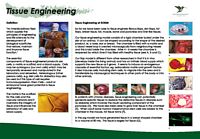


The development of microvascular surgery in Australia
Introduction
Participants
Beginnings
Developing links with academia and hospital medicine
A bevy of supporters
An ever-widening circle of contributors
Building research capacity
Nurturing relationships
Raising funds for research and development
The microsurgeon and the law
Winning community and corporate support
Leadership
The Institute and its style
Endnotes
Index
Search
Help
Contact us

James Angus: I guess collaboration is the other thing now. You can't do it all in house. There are skills that you can seek and the smart ones know in that network to all help each other.
Wayne Morrison: Yes, perhaps, if I might mention, a new area of research we are doing is tissue engineering.[73] Again, it's an area that has developed logically from microsurgery because tissue engineering in most spheres is done in the laboratory at the moment - in dishes where youíre talking about a very thin layer of cells growing that donít need much nourishment. If you actually try to transplant those into the body, they need a circulation or a vascularisation. And again, with our background in plastic surgery and microsurgery, itís the blood vessels that keep things alive. So here we are poised to be big players in three dimensional tissue engineering. Then of course youíre talking about stem cells and all the other exciting things that can be used to attract vital research funding from the public and from business because itís very modern in a sense.

Ken Knight: John Hurley was a world expert in wound healing and I think that was something which leant itself to research in microsurgery and plastic surgery where the idea was to search for scarless healing. Through the 1990s when John Hurley was most active in the research laboratory, that was one of the fields he was pursuing, together with Michael [Hickey] and others.
I guess with these collaborations we've had over the period of time weíve also been engaged in research fields such as neuroscience. When Aurora Messina arrived she had expertise in that area so we spent quite a lot of time looking at nerve repair and that obviously has direct application to hand surgery. So there have been a number of different fields that have all come together. And the lessons learned from wound healing now have great application in tissue engineering, - many of the same principles apply.
Ann Westmore: Is surgery poised to move into a whole new domain, for example with the stem cell work, and is that reflected at the NHMRC level by increasing interest in making sure that Australia can make that jump?
Wayne Morrison: Yes, funding is a topical thing. You have to be, in a sense, in the trend areas. Unless you're in those youíre not going to be a winner. So you have to be opportunistic all along. I should say that St Vincentís Hospital is very much a partner of the OíBrien Institute and shouldnít be seen as a separate thing. Our profile has been influenced very much by our access to patients who, unfortunately, sustain these horrendous injuries. They [the patients] have become, in many cases, great friends and ambassadors for us. So itís a partnership between the hospital and the research centre. Itís a great asset for all research institutes if they can have a link with a teaching hospital. This is what is very fortunate for surgery, in that itís what they call translational research where you can quickly transfer the research from the laboratory into patient care. That can be more difficult for bigger institutes which are essentially separate from hospitals.
 |
Witness to the History of Australian Medicine |  |
© The University of Melbourne 2005-16
Published by eScholarship Research Centre, using the Web Academic Resource Publisher
http://witness.esrc.unimelb.edu.au/057.html